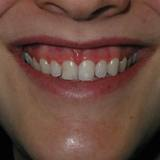Sitting a close second behind that of one’s eyes, the smile is the face’s greatest expression of emotion. The movement of the upper lip in a smile exposes the underlying teeth which plays a role in how attractive that smile appears. While the teeth are exposed in a smile, the gum tissue usually is not. When more than a little gum tissue appears between the upper lip and the teeth, it becomes known as the gummy smile.

Treatments for the gummy smile are far from established or standard. Even though very large gummy smiles are best treated by a maxillary impaction (LeFort 1 osteotomy), that option requires a commitment of a course of orthodontics and a significant surgical procedure. In gummy smiles less than 6mms, most patients will be resistant to such a ‘drastic’ approach.
Soft tissue management of the gummy smile has been based on two goals; to diminish how far the upper lip moves (muscle weakening and/or release) and techniques to bring the upper lip down. (lengthen vertically) The combination of both approaches is really needed to make a significant difference in the appearance of the gummy smile. Neither approach alone has been shown to be effective long-term.
One of the primary upper lip elevators is the levator labii superioris. From its origin below the lower rim of the eye socket to its insertion into the underside of the skin of the upper lip, this vertical strip of muscle runs just outside of the nostril. Severing this muscle can be done from an incision inside the nostril and does weaken upper lip excursion. (as has been shown by Botox injections) But keeping the muscle ends from healing and returning to normal excursion requires something else. This is where the role of the spacer has been shown to be effective. Using a premaxillary implant after muscle release can help the muscle ends from healing back together again. At the least, this spacer helps push the upper lip down. While advocates for this spacer in the past have used synthetic materials, I prefer the use of rolled allogeneic dermis. It is soft, can not be felt like an implant, and will integrate naturally into the surrounding tissues. This is a better way to introduce scar between the muscle ends without risk of long-term complications.
The other component of soft tissue management is upper lip release and lengthening. The upper lip can be released from the inside and its attachments freed up from the bone along the pyriform aperture to the canine fossa. By making the initial incision vertically through release of the maxillary frenum, such released upper lip tissue can be put back together in a classic V-Y closure pattern which will provide some upper lip length from the inside. When combined with a levator myotomy and spacer, realistic gains in upper lip length and decrease in gingival show can be anywhere from 2 to 6mms.
Such soft tissue gummy smile reconstruction can be done as an outpatient procedure under IV sedation in a simple one hour procedure. While it could also be performed under local anesthesia, patient comfort is better under some a little sedation. There will be some considerable swelling of the upper lip which returns to normal in about 10 days. The upper lip will move a little unnaturally for a few weeks after surgery. While the amount of gummy smile reduction will vary per patient, there are no long-term risks or deformity than can occur from this approach.
Dr. Barry Eppley
Indianapolis, Indiana


